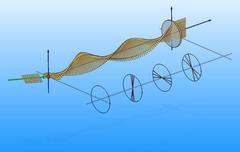URL: https://www.desy.de/news/news_search/index_eng.html
Breadcrumb Navigation
DESY News: Twisted X-rays reveal spin waves
News
News from the DESY research centre
Twisted X-rays reveal spin waves
A novel radar trap for atoms allows glimpses of hitherto invisible details of the magnetic dynamics of materials. The concept proposed by DESY scientist Ralf Röhlsberger extends the scope of a method called inelastic X-ray spectroscopy. It can be used to observe wave-like excitations in magnetic materials, so-called spin waves. The measuring principle, which is now presented in the scientific journal Physical Review Letters, avoids the problems existing analysis methods have and could eventually even make it possible to examine the complete magnetic dynamics of a system with just one pulse of X-rays. This will make it possible, for example, to investigate fast switching processes in future magnetic data storage.

Scattering X-ray light off moving atoms, changes the energy and thus the wavelength of the light. This principle, the so-called Doppler effect, is the basis of a method called inelastic X-ray scattering. Similar to a radar trap, which determines the velocity of a moving vehicle by analysing the wavelength change of the scattered radar radiation, atomic motions like lattice vibrations in crystals can be analysed by performing scattering experiments with intensive X-ray light from particle accelerators. The problem is that the energy of the light undergoes only a minimal change in the scattering process – a billionth fraction of its energy. For that reason only light from a very narrow energy or wavelength range can be used for these experiments. On the other hand, the X-ray radiation provided by a particle accelerator has a wide energy spectrum. Thus, nearly all of the synchrotron radiation has to be discarded and thus remains unexploited. The consequence is that, in spite of extremely powerful X-ray sources, the intensity of the usable light will become too weak to do these experiments.
A way out of this situation is a new analysis method proposed by Professor Ralf Röhlsberger: instead of measuring the energy difference during the scattering process, his energy analysis method uses another, so far almost unnoticed influence on the sample on the polarisation of the scattered radiation. Upon inelastic scattering of X-ray light off a magnetic sample, not only the energy of the scattered photons changes but there is also a twist of the orientation of their polarisation plane: the spin waves in the observed sample transform the polarisation, i.e. the oscillations plane of the scattered photons, to a kind of circular motion, also called precession. “This circular motion is equally characteristic for the magnetic excitation in the system as is the energy shift in the conventional method,” said Röhlsberger, who teaches at the University of Hamburg and is a member of the Cluster of Excellence of the Hamburg Centre for Ultrafast Imaging (CUI). “When measuring this precession in relation to the incident reference beam, one gets a fingerprint of the spin wave spectrum in the sample.”
The great advantage of this concept is the possibility to use a considerably wider energy band instead of a very narrow energy range for the investigation without losing accuracy. A measuring principle with similar properties for scattering experiments with neutrons, the so-called neutron spin echo, has already been in use for a long time to explore dynamic processes in solids with highest energy resolution. However, it is much easier to carry out this method with neutrons, since every change of energy has a direct effect on their velocity which allows the accurate determination of their energy. This method cannot be applied directly to photons, because these are always travelling at the speed of light, independent of their energy. “This was the reason why I looked for a spectroscopic method for photons, the energy resolution of which is independent of the bandwidth of the probing radiation,” said Röhlsberger.
First tests to verify the feasibility of this new method, which Röhlsberger and his team carried out at the European Synchrotron Radiation Facility ESRF, produced promising results. When / If this method is established, it will enable wide-ranging applications, extending from the study of magnetic switching processes to excitation spectra of artificially structured magnetic materials for magneto-optical information technology. The low-energetic dynamics of complex magnetic materials remain a particular mystery to scientists that could be solved with the help of this new method.
“This method does not only work with synchrotron light sources like PETRA III but can also be used for investigations with X-ray lasers like the European XFEL that currently under construction between the DESY site in Hamburg Bahrenfeld and the neighbouring town of Schenefeld in Schleswig-Holstein. The idea is that in the end we will capture the whole dynamics of a magnetic system with a single X-ray pulse from the European XFEL.”



